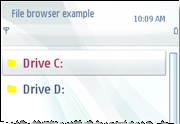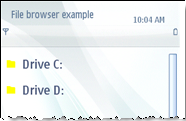Modifying applications to support single-tap
Symbian^3 enhances the touch interaction by providing support for single-tap.
S60 5th Edition introduced touch support feature with double-tap to maintain binary and source code compatibility with the existing S60 3.x applications. The UI was focus driven, with the first tap for object selection (the corresponding event forwarded to the application) and the second tap for activation.
By default, none of the menu items are highlighted.
Item specific options are displayed in stylus menus rather than in options menus.
The side toolbar is hidden in the landscape layout view except in specific applications like the message viewer and editor.
It is highly recommended that you migrate your applications to single-tap to complement the platform UI behavior. However, if you do not migrate your applications to single-tap, they work the same way as in S60 5th Edition (touch support with double-tap).
- Hiding item-specific commands in menus
The item-specific commands and item-action commands in options menu must be flagged with the EEikMenuItemSpecific and EEikMenuItemAction flags introduced in Symbian^3. This enables the UI framework to hide them in the options menu and display them only in the stylus pop-up menu. The touch down and hold action opens the stylus pop-up menu. Touch down and release performs an action. - Hiding item-specific commands in submenus
This document describes the changes required to your application's code for hiding item-specific commands in submenus. - Removing item-specific commands from the toolbar
This document describes the changes required to your code to remove the item-specific commands from the toolbar. - Activating items in a list
This document describes the code changes required to activate items in a list on single-tap. - Disabling stylus popup menus in AVKON lists
This document describes how to disable stylus popup menus in AVKON lists. - Disabling hardware key shortcuts
This document describes how to disable hardware key shortcuts when none of the items in a list are highlighted.
Copyright ©2010 Nokia Corporation and/or its subsidiary(-ies).
All rights
reserved. Unless otherwise stated, these materials are provided under the terms of the Eclipse Public License
v1.0.

